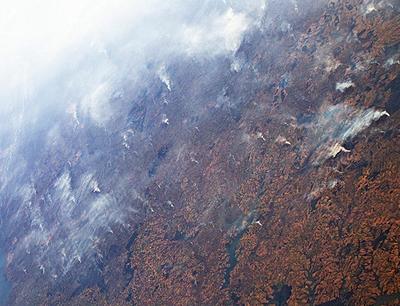
ALCALA de HENARES, Spain, March 6, 2020 (ENS) – Thousands of fires broke out in the Amazon last year, sparking international media alarm. But a detailed analysis, using data from the European Space Agency’s Climate Change Initiative, shows that while there was a small increase of fires in 2019 compared to 2018, the number of fires in Brazil was similar to the average annual number of fires detected over the past 18 years.
While forest fires are common in the Amazon, they vary considerably from year-to-year driven by changes in climate, as well as variations in deforestation and forest degradation.

The attention on fires last year, which created great international concern crossing the limits of national policies, prompted an international demand for up-to-date information on active fires, particularly in Brazil.
Yet these numbers were never compared to the number of fires in the Amazon over a longer period of time.
Detailed in a recent paper published in the journal “Remote Sensing,” scientists using data from the European Space Agency’s Fire CCI project <https://www.esa-fire-cci.org/node/2>, analyzed burned areas in South America in both 2018 and 2019 and compared the data to the 2001-18 yearly average.
The authors are affiliated with the Environmental Remote Sensing Research Group in the Department of Geology, Geography and the Environment at the Universidad de Alcalá in Spain.
They found that the total burned area in South America was around 70 percent more in 2019 compared to the same period of 2018, however only slightly more than the yearly average over the past 17 years.
Brazil experienced just a 1.7 percent increase of burned area in 2019 compared to the long-term average.
Bolivia, on the other hand, saw a 51.4 percent increase of burned areas in 2019, compared to the yearly average.
Emilio Chuvieco, science leader of the Fire CCI project and one of the paper’s three authors, said, “Studies such as these are important to quantify and monitor fire activities in places such as the Amazon. However, they indicate the importance of long-term data series and studies using higher resolution sensors, such as the Copernicus Sentinel-2 multispectral instrument, to detect fires.”
Earth-observing satellites can be used to detect and monitor fires over frequently affected areas. These burned area estimates are from ESA’s Fire Climate Change Initiative project, which produces long-term datasets of burned area information from satellites, as part of the ESA Climate Change Initiative.
The data is useful for those interested in historical burned patterns, fire management and emissions analysis and climate change research, by providing a consistent burned area time series.
In the last decades, the anthropogenic pressure over the Amazon region has been continuously increasing, mostly linked to agricultural expansion. The increasing fire activity in the region is strongly linked to deforestation and forest degradation, the study shows.
Josef Aschbacher, ESA’s Director of Earth Observation Programmes, said, “These observations show the challenge we are facing – the processes on Earth and in the forests are very dynamic. The unusual increase of fire activity in 2019 demonstrates that satellite data is essential to get a clear and independent picture in order to also understand long-term trends.”
Tropical forests shelter around half of the world’s biodiversity, and are considered a fundamental part of Earth’s ecosystem. Quantifying fires in forests is important for the ongoing study of climate, as they have a significant impact on atmospheric emissions, with biomass burning contributing to the global budgets of greenhouse gases.
“As a general summary,” the scientists conclude, “the high political controversy about new fires in the region should be more clearly applicable to Bolivia and Venezuela than to Brazil, which in 2019 had higher BAs [burned areas] than the previous year, but still around the average of the full-time series…”
“However, it is a major concern to identify areas in the Amazon region that were widely affected by fires in 2019 and had previously little or no fire occurrence, including regions in Brazil, Bolivia, Paraguay, Venezuela and Peru,” the scientists write in their study. “Agricultural expansion has been identified by several studies as being behind the introduction of fire in these regions, but more detailed studies need to be carried out to detect the local drivers of fire.”
Copyright Environment News Service (ENS) 2020. All rights reserved.
© 2020, Environment News Service. All rights reserved. Content may be quoted only with proper attribution and a direct link to the original article. Full reproduction is prohibited.
